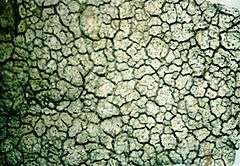Aspicilia
| Aspicilia | |
|---|---|
 | |
| Aspicilia cinerea | |
| Scientific classification | |
| Kingdom: | Fungi |
| Division: | Ascomycota |
| Class: | Ascomycetes |
| Order: | Pertusariales |
| Family: | Megasporaceae |
| Genus: | Aspicilia A.Massal. (1852) |
| Type species | |
| Aspicilia cinerea (L.) Körb. (1855) | |
Aspicilia (sunken disk lichen) is a genus of mostly crustose areolate lichens that grow on rock. Most members have black apothecia discs that are slightly immersed in the areolas, hence the common name.[1]:223
Most of the species of this genus grow on calcareous and acidic rocks and most of the taxa prefer temperate and arctic habitats.
Some members of the ‘‘Aspicilia’‘ genus are pioneer species on granite and other hard rock, after which members of other lichen species may grow on them, such as members of Acarospora.[2]
Description
Members of this genus are weakly cracked to distinctly areolate, with a scattered to whole thalli. Some of the species of this genus are disc-shaped with plicate lobes at the circumference; these lobes may appear chalky white, grayish, greenish or brownish. Some possess vegetative means of propagation such as isidia (column-like structures of fungal and algal cells normally found on the top-side or outer cortex of the lichen) and soredia (structures that produce soralia, granule-like masses of intertwined fungal and algal cells occurring on top of the cortex and on the margins).
They have characteristic ascomata which are mostly immersed but occasionally emergent. They have 4 to 8 spored asci that are cylindrical to club-shaped. Their ascospores are typically ellipsoid to globose in shape, colorless and thin-walled. They often contain β-orcinol depsidones (secondary metabolites of lichens) such as norstictic acid and stictic acids; others have fatty acids or triterpenes. In genus Aspicilia dramatic changes in growth forms are very common, and some taxa may display extreme transitions within the same population or even changes within the same thallus.[3]
Classification
Previously placed in the family Hymeneliaceae, phylogenetic analyses indicate that the genus is better placed in the family Megasporaceae.[4]
Species list
- A. almorensis
- A. alphoplaca
- A. alpina
- A. caesiocinerea
- A. calcarea
- A. californica
- A. cernohorskyana
- A. chadefaudiana
- A. cinerea
- A. coerulea
- A. confusa
- A. contorta
- A. crespiana
- A. cuprea
- A. cyanescens
- A. desertorum
- A. dwaliensis
- A. endochlora
- A. epiglypta
- A. excavata
- A. flavida
- A. fructiculosa
- A. grisea
- A. griseocinerea
- A. intermutans
- A. hoffmannii
- A. laevata
- A. leprosescens
- A. maculata
- A. mansourii
- A. melanaspis
- A. moenium
- A. myrini
- A. oxneriana
- A. parasitica
- A. pacifica
- A. phaea
- A. praeradiosa
- A. prevostii
- A. quartzitica
- A. recedens
- A. simoënsis
- A. subcandida
- A. subcircinata
- A. subdepressa
- A. tuberculosa
- A. uxoris
- A. verrucigera
- A. volcanica – China[5]
Gallery
-

Photograph of a cross section of an apothecium of A. caesiocinerea taken through a compound microscope, x 100. Note the dark olive epihymenium.
-

Photograph of a section of an apothecium of A. cinerea taken through a compound microscope (x400) showing algae in the amphithecium of the thalline margin. (Lecanorine-type apothecium)
-

Photograph of an ascus from A. caesiocinerea taken through a compound microscope (x1000) showing 8 spores per ascus. (Spores measure approximately 15 x 11 micrometres.)
References
- ↑ Field Guide to California Lichens, Stephen Sharnoff, Yale University Press, 2014, ISBN 978-0-300-19500-2
- ↑ ACAROPSPORA, Lichen Flora of the Greater Sonoran Desert Region. Vol 3., Nash, T.H., Ryan, B.D., Gries, C., Bugartz, F., (eds.) 2001,
- ↑ Weber WA. (1967). "Environmental modification in crustose lichens. II. Fruticosa growth forms in Aspicilia". Aquilo. Ser. Bot. 6: 43–51.
- ↑ Schmitt I, Yamamoto Y, Lumbsch HT (2006). "Phylogeny of Pertusariales (Ascomycotina): Resurrection of Ochrolechiaceae and new circumscription of Megasporaceae". Journal of the Hattori Botanical Laboratory. 100: 753–64.
- ↑ Ismayil I, Abbas A, Gup S-Y (2015). "Aspicilia volcanica, a new saxicolous lichen from Northeast China". Mycotaxon. 120 (2): 543–548. doi:10.5248/130.543.
External links
| Wikimedia Commons has media related to Aspicilia. |


